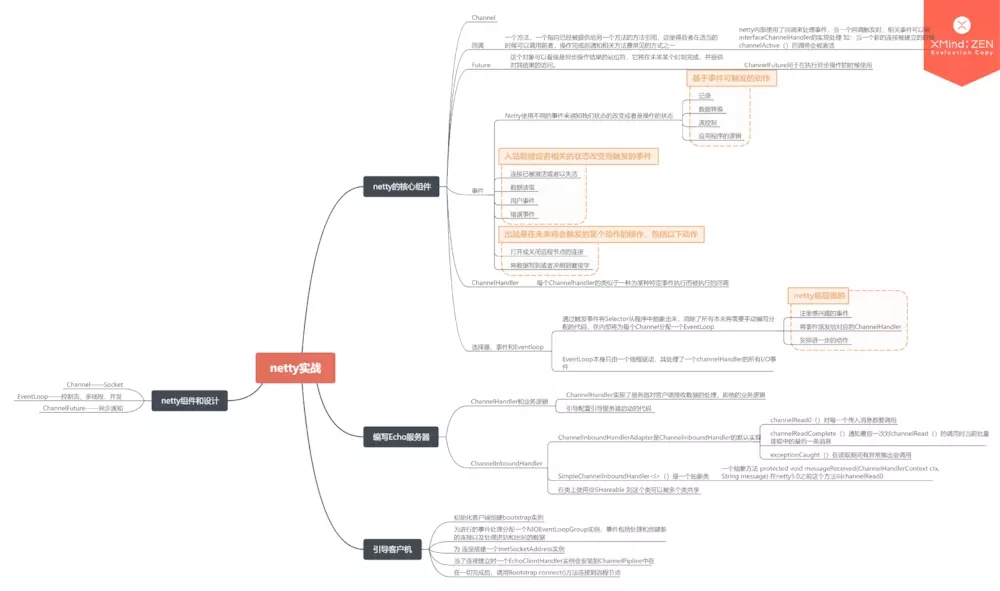之前花了几天去研究怎么使用netty做一个网关服务器,虽然最后还是没能用上我做的网关,但是呢netty是会用了,总结一下netty和spring boot整合。感觉不用spring boot都不会写代码了。哈哈哈
在pom文件中添加相关的依赖,这里主要的就是netty的依赖,spring boot的相关依赖本文不提
<dependency>
<groupId>io.netty</groupId>
<artifactId>netty-all</artifactId>
<version>4.1.19.Final</version>
</dependency>
<dependency>
<groupId>SpringBoot-Netty</groupId>
<artifactId>SpringBoot-Netty</artifactId>
<version>1.0-SNAPSHOT</version>
</dependency>
在application.yml文件中配置
#不能用localhost,否则启动报异常:Unresolved address #tcp监听的端口 tcp: port: 8090 # bossGroup的线程数 boss: thread: count: 2 # worker的线程数 worker: thread: count: 2 #是否使用长连接 so: keepalive: true backlog: 100
3.编写NettyConfig netty的配置。
package com.advsun.netty.config;
import com.advsun.netty.handlers.StringProtocolInitalizer;
import io.netty.bootstrap.ServerBootstrap;
import io.netty.channel.ChannelOption;
import io.netty.channel.nio.NioEventLoopGroup;
import io.netty.channel.socket.nio.NioServerSocketChannel;
import io.netty.handler.codec.string.StringDecoder;
import io.netty.handler.codec.string.StringEncoder;
import org.springframework.beans.factory.annotation.Autowired;
import org.springframework.beans.factory.annotation.Qualifier;
import org.springframework.beans.factory.annotation.Value;
import org.springframework.context.annotation.Bean;
import org.springframework.context.annotation.Configuration;
import org.springframework.context.support.PropertySourcesPlaceholderConfigurer;
import java.net.InetSocketAddress;
import java.util.HashMap;
import java.util.Map;
import java.util.Set;
/**
* @author 杨红星
* @version 1.0.0
*/
@Configuration
public class NettyConfig {
//读取yml中配置
@Value("${boss.thread.count}")
private int bossCount;
@Value("${worker.thread.count}")
private int workerCount;
@Value("${tcp.port}")
private int tcpPort;
@Value("${so.keepalive}")
private boolean keepAlive;
@Value("${so.backlog}")
private int backlog;
@Autowired
@Qualifier("springProtocolInitializer")
private StringProtocolInitalizer protocolInitalizer;
//bootstrap配置
@SuppressWarnings("unchecked")
@Bean(name = "serverBootstrap")
public ServerBootstrap bootstrap() {
ServerBootstrap b = new ServerBootstrap();
b.group(bossGroup(), workerGroup())
.channel(NioServerSocketChannel.class)
.childHandler(protocolInitalizer);
Map<ChannelOption<?>, Object> tcpChannelOptions = tcpChannelOptions();
Set<ChannelOption<?>> keySet = tcpChannelOptions.keySet();
for (@SuppressWarnings("rawtypes")
ChannelOption option : keySet) {
b.option(option, tcpChannelOptions.get(option));
}
return b;
}
@Bean(name = "bossGroup", destroyMethod = "shutdownGracefully")
public NioEventLoopGroup bossGroup() {
return new NioEventLoopGroup(bossCount);
}
@Bean(name = "workerGroup", destroyMethod = "shutdownGracefully")
public NioEventLoopGroup workerGroup() {
return new NioEventLoopGroup(workerCount);
}
@Bean(name = "tcpSocketAddress")
public InetSocketAddress tcpPort() {
return new InetSocketAddress(tcpPort);
}
@Bean(name = "tcpChannelOptions")
public Map<ChannelOption<?>, Object> tcpChannelOptions() {
Map<ChannelOption<?>, Object> options = new HashMap<ChannelOption<?>, Object>();
options.put(ChannelOption.SO_KEEPALIVE, keepAlive);
options.put(ChannelOption.SO_BACKLOG, backlog);
return options;
}
@Bean(name = "stringEncoder")
public StringEncoder stringEncoder() {
return new StringEncoder();
}
@Bean(name = "stringDecoder")
public StringDecoder stringDecoder() {
return new StringDecoder();
}
/**
* Necessary to make the Value annotations work.
*
* @return
*/
@Bean
public static PropertySourcesPlaceholderConfigurer propertyPlaceholderConfigurer() {
return new PropertySourcesPlaceholderConfigurer();
}
}
4.初始化的相关配置
package com.advsun.netty.handlers;
import io.netty.channel.ChannelInitializer;
import io.netty.channel.ChannelPipeline;
import io.netty.channel.socket.SocketChannel;
import io.netty.handler.codec.string.StringDecoder;
import io.netty.handler.codec.string.StringEncoder;
import org.springframework.beans.factory.annotation.Autowired;
import org.springframework.beans.factory.annotation.Qualifier;
import org.springframework.stereotype.Component;
/**
* @author 杨红星
* @version 1.0.0
*/
@Component
@Qualifier("springProtocolInitializer")
public class StringProtocolInitalizer extends ChannelInitializer<SocketChannel> {
@Autowired
StringDecoder stringDecoder;
@Autowired
StringEncoder stringEncoder;
@Autowired
ServerHandler serverHandler;
@Override
protected void initChannel(SocketChannel ch) throws Exception {
ChannelPipeline pipeline = ch.pipeline();
pipeline.addLast("decoder", stringDecoder);
pipeline.addLast("handler", serverHandler);
pipeline.addLast("encoder", stringEncoder);
}
public StringDecoder getStringDecoder() {
return stringDecoder;
}
public void setStringDecoder(StringDecoder stringDecoder) {
this.stringDecoder = stringDecoder;
}
public StringEncoder getStringEncoder() {
return stringEncoder;
}
public void setStringEncoder(StringEncoder stringEncoder) {
this.stringEncoder = stringEncoder;
}
public ServerHandler getServerHandler() {
return serverHandler;
}
public void setServerHandler(ServerHandler serverHandler) {
this.serverHandler = serverHandler;
}
}
5.tcp服务的配置
package com.advsun.netty.config;
import io.netty.bootstrap.ServerBootstrap;
import io.netty.channel.ChannelFuture;
import org.springframework.beans.factory.annotation.Autowired;
import org.springframework.beans.factory.annotation.Qualifier;
import org.springframework.stereotype.Component;
import javax.annotation.PostConstruct;
import javax.annotation.PreDestroy;
import java.net.InetSocketAddress;
/**
* @author 杨红星
* @version 1.0.0
*/
@Component
public class TCPServer {
@Autowired
@Qualifier("serverBootstrap")
private ServerBootstrap b;
@Autowired
@Qualifier("tcpSocketAddress")
private InetSocketAddress tcpPort;
private ChannelFuture serverChannelFuture;
@PostConstruct
public void start() throws Exception {
System.out.println("Starting server at " + tcpPort);
serverChannelFuture = b.bind(tcpPort).sync();
}
@PreDestroy
public void stop() throws Exception {
serverChannelFuture.channel().closeFuture().sync();
}
public ServerBootstrap getB() {
return b;
}
public void setB(ServerBootstrap b) {
this.b = b;
}
public InetSocketAddress getTcpPort() {
return tcpPort;
}
public void setTcpPort(InetSocketAddress tcpPort) {
this.tcpPort = tcpPort;
}
}
6.serverHandler配置这里是实现业务逻辑的地方
package com.advsun.netty.handlers;
import io.netty.channel.ChannelHandler;
import io.netty.channel.ChannelHandlerContext;
import io.netty.channel.SimpleChannelInboundHandler;
import org.slf4j.Logger;
import org.slf4j.LoggerFactory;
import org.springframework.beans.factory.annotation.Qualifier;
import org.springframework.stereotype.Component;
import java.net.InetAddress;
/**
* @author 杨红星
* @version 1.0.0
*/
@Component
@Qualifier("serverHandler")
@ChannelHandler.Sharable
public class ServerHandler extends SimpleChannelInboundHandler<String> {
private static final Logger log = LoggerFactory.getLogger(ServerHandler.class);
@Override
public void channelRead0(ChannelHandlerContext ctx, String msg)
throws Exception {
log.info("client msg:"+msg);
String clientIdToLong= ctx.channel().id().asLongText();
log.info("client long id:"+clientIdToLong);
String clientIdToShort= ctx.channel().id().asShortText();
log.info("client short id:"+clientIdToShort);
if(msg.indexOf("bye")!=-1){
//close
ctx.channel().close();
}else{
//send to client
ctx.channel().writeAndFlush("Yoru msg is:"+msg);
}
}
@Override
public void channelActive(ChannelHandlerContext ctx) throws Exception {
log.info("RamoteAddress : " + ctx.channel().remoteAddress() + " active !");
ctx.channel().writeAndFlush( "Welcome to " + InetAddress.getLocalHost().getHostName() + " service!\n");
super.channelActive(ctx);
}
@Override
public void exceptionCaught(ChannelHandlerContext ctx, Throwable cause) {
cause.printStackTrace();
ctx.close();
}
@Override
public void channelInactive(ChannelHandlerContext ctx) throws Exception {
log.info("\nChannel is disconnected");
super.channelInactive(ctx);
}
}
这里的 channelRead0(ChannelHandlerContext ctx, String msg)当客户机有消息发送过来时会调用这个方法,这个方法的名字叫的是真的差,所以netty5.0之后取消了这个名字, 5.0之后叫messageReceived。官方都说这名字叫的傻逼
channelRead0() → messageReceived() I know. It was a silly mistake. If you are using SimpleChannelInboundHandler, you have to rename channelRead0() to messageReceived().
最后在贴一张自己在看netty实战时候画的思维导图
